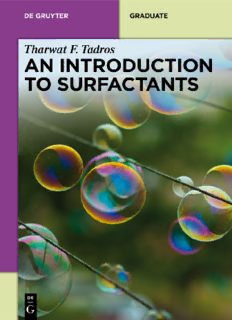
An Introduction to Surfactants PDF
Preview An Introduction to Surfactants
DeGruyterGraduate Tadros∙AnIntroductiontoSurfactants Also of Interest MarkAnthonyBenvenuto IndustrialChemistry,2013 ISBN978-3-11-029589-4,e-ISBN978-3-11-029590-0 MarioLeclerc,RobertGauvin(Eds.) FunctionalMaterials–ForEnergy,SustainableDevelopment andBiomedicalSciences,2014 ISBN978-3-11-030781-8,e-ISBN978-3-11-030782-5 AngelaDibenedetto,MicheleAresta(Eds.) InorganicMicro-andNanomaterials–Synthesisand Characterization,2013 ISBN978-3-11-030666-8,e-ISBN978-3-11-030687-3, SetISBN978-3-11-030688-0 ChallaKumar(Editor-in-Chief) NanotechnologyReviews ISSN2191-9097 www.degruyter.com Tharwat F. Tadros An Introduction to Surfactants | Author Prof.TharwatF.Tadros 89NashGroveLane WokinghamRG404HE Berkshire,UK Email:[email protected] ISBN978-3-11-031212-6 e-ISBN978-3-11-031213-3 LibraryofCongressCataloging-in-PublicationData ACIPcatalogrecordforthisbookhasbeenappliedforattheLibraryofCongress. BibliographicinformationpublishedbytheDeutscheNationalbibliothek TheDeutscheNationalbibliothekliststhispublicationintheDeutscheNationalbibliografie; detailedbibliographicdataareavailableintheInternetathttp://dnb.dnb.de. ©2014WalterdeGruyterGmbH,Berlin/Boston Coverimage:stasy1980/iStock/Thinkstock Typesetting:PTP-Berlin,ProtagoTEX-ProduktionGmbH,www.ptp-berlin.de Printingandbinding:Hubert&Co.,Göttingen ♾Printedonacid-freepaper PrintedinGermany www.degruyter.com Preface Surfactantsfindapplicationinalmosteverychemicalindustryofwhichthefollowing maybeworthmentioning:detergents,paints,dyestuffs,cosmetics,pharmaceuticals, agrochemicals,fibers,plastics,etc.Moreover,surfactantsplayamajorroleintheoil industry,forexampleinenhancedandtertiaryoilrecovery.Theyarealsooccasionally used for environmentalprotection,e.g. in oil slick dispersants.Therefore, a funda- mentalunderstandingofthephysicalchemistryofsurfaceactiveagents,theirunusual propertiesandtheirphasebehaviorisessentialformostindustrialchemists.Inaddi- tion,anunderstandingofthebasicphenomenainvolvedintheapplicationofsurfac- tants,suchasinthepreparationofemulsionsandsuspensionsandtheirsubsequent stabilization,innanoemulsions,inmicroemulsions,inwettingspreadingandadhe- sion,etc.,isofvitalimportanceinarrivingattherightcompositionandcontrolofthe systeminvolvedThisbookhasbeenwrittenasanintroductiontograduatechemists, industrialformulatorswhoareusingsurfactantsintheaboveapplications.Asfaras possible,thebookiswritteninasimplewaywithouttoomuchdetailinordertoen- ablethereadertomakeastartwiththebasicphysicalphenomenainvolvedinsucha vastfield.Formoredetail,thereadercanrefertomorecomprehensivebooksedited orwrittenbytheauthor(suchas“AppliedSurfactants”,Wiley,2005;“Encyclopedia ofColloidandInterfaceScience”,Springer,2013). Thisbookstartswithageneralintroduction(Chapter1)tointroducethesubject andexplainthebookstructure.Chapter2givesageneralclassificationofsurfactants basedonthenatureoftheheadgroup(anionic,cationic,zwitterionicandnonionic), adescriptionofsomespecializedmoleculessuchasfluorocarbonandsiliconesur- factants (referred to as superwetters), sugar-based surfactants, naturally occurring surfactantsandpolymericsurfactants.Chapter3dealswiththeunusualproperties ofsurfactantsolutionsandtheprocessofmicellization.Thedifferentself-assembly structures that are produced in surfactant solutions are described in terms of their structuresandphasebehavior.Chapter4describestheprocessofsurfactantadsorp- tionattheair/liquid(A/L),liquid/liquid(L/L)andsolid/liquid(S/L)interfaces.The experimentaltechniquesthatcanbeappliedformeasuringsurfactantadsorptionat variousinterfacesarebrieflydescribed.Chapter5describestheuseofsurfactantsas emulsifierswithparticularattentiontothemethodsthatcanbeappliedforselection ofemulsifiersforagivenoilusedintheemulsion.Theroleofsurfactantsinstabilizing theemulsionagainstflocculation,Ostwaldripeningandcoalescenceisalsodescribed atafundamentallevel.Chapter6describestheuseofsurfactantsasdispersantsfor suspensions. The process of dispersion of powders in liquids is described in terms ofwetting,dispersionandstabilizationoftheresultingsuspensionagainstfloccula- tion.Chapter7dealswithsurfactantsinfoamformationandstabilization.Thetheo- riesoffoamstabilizationandtheroleofsurfactantsaredescribed.Applicationofsur- factantsinformulationofnanoemulsions(withsizerange20–200nm)isdescribedin vi | Preface Chapter8.Thevariousmethodsthatcanbeappliedforpreparationofnanoemulsions aredescribed.Chapter9describesmicroemulsionsandtheoriginoftheirthermody- namic stability. The various methods that can be applied for formulation of micro- emulsionsaredescribed.Theuseofsurfactantsaswettingagentswillbedescribedin Chapter10.Particularattentionisgiventothefundamentalsofwettingandspreading withparticularreferencetosurfactantsthatcanbeusedaswettingagents.Thefinal Chapter11dealswithapplicationsofsurfactantsinselectedindustries:Cosmetics– Pharmaceuticals–Agrochemicals–PaintsandCoatings–Detergents. Thisbookcanbeusefulforteachingundergraduateandgraduatestudents.Itis alsovaluableforindustrialchemistswhoareinvolvedinformulationofdispersesys- tems,wheresurfactantsareessentialingredientsinsuchformulations. Berkshire,2014 TharwatF.Tadros Contents Preface|v 1 Generalintroduction|1 2 Generalclassificationofsurfactants|5 2.1 Anionicsurfactants|5 2.1.1 Carboxylates|6 2.1.2 Sulfates|6 2.1.3 Sulfonates|7 2.1.4 Isethionates|8 2.1.5 Taurates|9 2.1.6 Phosphate-containinganionicsurfactants|9 2.2 Cationicsurfactants|9 2.3 Amphoteric(zwitterionic)surfactants|11 2.4 Nonionicsurfactants|12 2.4.1 Alcoholethoxylates|12 2.4.2 Alkylphenolethoxylates|13 2.4.3 Fattyacidethoxylates|13 2.4.4 Sorbitanestersandtheirethoxylatedderivatives(Spansand Tweens)|13 2.4.5 Ethoxylatedfatsandoils|15 2.4.6 Amineethoxylates|15 2.4.7 Amineoxides|15 2.5 Specialitysurfactants|16 2.5.1 Fluorocarbonandsiliconesurfactants|16 2.5.2 Geminisurfactants|17 2.5.3 Surfactantsderivedfrommono-andpolysaccharides|17 2.5.4 Naturallyoccurringsurfactants|18 2.5.5 Biosurfactants|22 2.5.6 Polymericsurfactants|24 3 Aggregationofsurfactants,self-assemblystructures,liquidcrystalline phases|29 3.1 Thermodynamicsofmicellization|36 3.1.1 Kineticaspects|36 3.1.2 Equilibriumaspects:Thermodynamicsofmicellization|37 3.2 Enthalpyandentropyofmicellization|39 3.3 Drivingforceformicelleformation|40 3.4 Micellizationinsurfactantmixtures(mixedmicelles)|42 viii | Contents 3.5 Surfactantself-assembly|45 3.5.1 Structureofliquidcrystallinephases|45 3.5.2 Hexagonalphase|46 3.5.3 Micellarcubicphase|47 3.5.4 Lamellarphase|47 3.5.5 Bicontinuouscubicphases|47 3.5.6 Reversedstructures|47 3.6 Experimentalstudiesofthephasebehaviorofsurfactants|48 4 Surfactantadsorptionatinterfaces|51 4.1 Introduction|51 4.2 Adsorptionofsurfactantsattheair/liquid(A/L)andliquid/liquid(L/L) interfaces|52 4.2.1 TheGibbsadsorptionisotherm|53 4.2.2 Equationofstateapproach|57 4.2.3 TheLangmuir,SzyszkowskiandFrumkinequations|58 4.3 Interfacialtensionmeasurements|59 4.3.1 TheWilhelmyplatemethod|59 4.3.2 Thependentdropmethod|60 4.3.3 TheDuNouy’sringmethod|61 4.3.4 Thedropvolume(weight)method|61 4.3.5 Thespinningdropmethod|61 4.4 Adsorptionofsurfactantsatthesolid/liquidinterface|62 4.4.1 Adsorptionofionicsurfactantsonhydrophobicsurfaces|64 4.4.2 Adsorptionofionicsurfactantsonpolarsurfaces|67 4.4.3 Adsorptionofnonionicsurfactants|69 5 Surfactantsasemulsifiers|73 5.1 Introduction|73 5.1.1 Natureoftheemulsifier|73 5.1.2 Structureofthesystem|74 5.1.3 Breakdownprocessesinemulsions|74 5.2 Physicalchemistryofemulsionsystems|77 5.2.1 Theinterface(Gibbsdividingline)|77 5.2.2 Thermodynamicsofemulsionformationandbreakdown|78 5.2.3 Interactionenergies(forces)betweenemulsiondropletsandtheir combinations|80 5.3 Mechanismofemulsification|85 5.3.1 Methodsofemulsification|86 5.3.2 Roleofsurfactantsinemulsionformation|88 5.3.3 Roleofsurfactantsindropletdeformation|89 5.4 Selectionofemulsifiers|92 Contents | ix 5.4.1 TheHydrophilic-LipophileBalance(HLB)concept|92 5.4.2 ThePhaseInversionTemperature(PIT)concept|95 5.5 Stabilizationofemulsions|97 5.5.1 Creamingorsedimentationanditsprevention|97 5.5.2 Flocculationofemulsionsanditsprevention|98 5.5.3 Ostwaldripeninganditsreduction|99 5.5.4 Emulsioncoalescenceanditsprevention|100 6 Surfactantsasdispersantsandstabilizationofsuspensions|103 6.1 Introduction|103 6.2 Roleofsurfactantsinpreparationofsolid/liquiddispersions (suspensions)|103 6.2.1 Roleofsurfactantsincondensationmethods.Nucleationand growth|104 6.2.2 Emulsionpolymerization|105 6.2.3 Dispersionpolymerization|107 6.2.4 Roleofsurfactantsindispersionmethods|109 6.3 Assessmentofwettabilityofpowders|115 6.3.1 Sinkingtime,submersionorimmersiontest|115 6.3.2 Measurementofcontactanglesofliquidsandsurfactantsolutionson powders|116 6.3.3 Listofwettingagentsforhydrophobicsolidsinwater|116 6.3.4 Stabilizationofsuspensionsusingsurfactants|118 7 Surfactantsforfoamstabilization|121 7.1 Introduction|121 7.2 Foampreparation|121 7.3 Foamstructure|122 7.4 Classificationoffoamstability|123 7.4.1 Drainageandthinningoffoamfilms|124 7.4.2 Theoriesoffoamstability|125 7.5 Foaminhibitors|129 7.5.1 Chemicalinhibitorsthatlowerviscosityandincreasedrainage|130 7.5.2 Solubilizedchemicalswhichcauseantifoaming|130 7.5.3 Dropletsandoillenseswhichcauseantifoamingand defoaming|130 7.5.4 Surfacetensiongradients(inducedbyantifoamers)|131 7.5.5 Hydrophobicparticlesasantifoamers|131 7.5.6 Mixturesofhydrophobicparticlesandoilsasantifoamers|132 7.6 Assessmentoffoamformationandstability|132 7.6.1 Efficiencyandeffectivenessofafoamingsurfactant|133
Description: